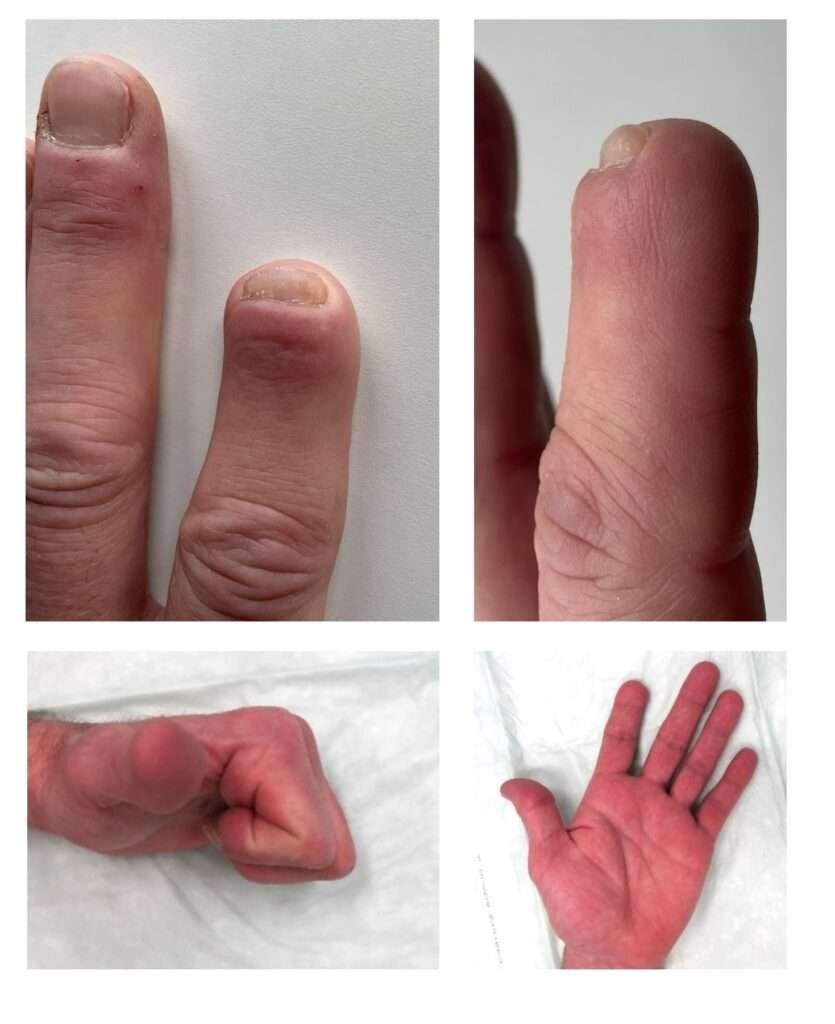Keywords: Fingertip amputation; hand trauma; local flap; eponychial flap; V-Y flap
Authors: Alina Strohmaier, MD, Martina Greminger, MD. Institution: HOCH Cantonal Hospital St. Gallen, Switzerland
Abstract
A 58-year-old male presented with fingertip amputation of the left index finger after a bicycle accident. The injury was classified as Ishikawa Zone 2/Allen Type III, with ulnar oblique pulp defect, subtotal nail bed loss but with intact germinative matrix, and exposed bone. Treatment involved a volar V-Y advancement flap for soft tissue coverage and an eponychial flap to allow visible nail growth. Postoperatively, early mobilization was conducted. At 6-month follow-up, the patient reported good functional outcomes. Examination revealed adequate soft tissue coverage, a normally growing but short nail without a claw-nail deformity, and a stable fingertip. The patient was able to play the piano again. A near-complete range of motion and normal sensation were achieved. This case demonstrates successful fingertip reconstruction using local flaps to restore function and maintain the nail, even when the nail bed is almost completely injured.
Patient medical history
A 58-year-old male patient presented to the emergency department with amputation of the distal phalanx of the second digit on the left dominant hand. The patient sustained the injury while inspecting the brakes of a bicycle, resulting in the second digit impacting the bicycle spoke. The patient is a professional piano player. No regular intake of medication.


Before and After
Patient examination
Emergency presentation of the patient with fingertip amputation (Ishikawa zone 2, Allen Type III) of the left index finger. Initial examination revealed an ulnar oblique amputation of the distal phalanx of the index finger (adominant). The visible part of the nail bed was almost completely injured; however, the germinative matrix remained intact. Sensitivity and blood circulation were preserved. Tendon function was intact for flexors and extensors. Exposed bone was visible. The amputate was available, but was injured in two pieces and therefore unsuitable for replantation. X-rays demonstrated a small radiopalmar dislocated and dorsally malaligned fracture fragment and intra-articular avulsion of the ulnar base.
Pre-operative considerations

Wound debridement and planning

VY-flap and eponychial flap

Suturing and perfusion control
To achieve an aesthetically and functionally pleasing outcome, an eponychium plasty was added to extend the visible part of the nail and enhance its appearance. The incision site and area designated for de-epithelialization were delineated. The available nail pocket measured approximately 4 mm. Deep radial and ulnar skin incisions were made, followed by de-epithelialization of the marked area using a scalpel. Subsequently, the flap was advanced proximally into the de-epithelialized region and secured using Prolene 4-0 sutures.

Follow up
Follow up with a great result, and a minor size decrease of the finger defect.
Pearls
Pitfalls
Post-operative plan
References
- Tos P, Crosio A, Adani R. Fingertip injuries and their reconstruction, focusing on nails. Hand Surg Rehabil. 2024;43S. doi:10.1016/J.HANSUR.2024.101675
- Peterson SL, Peterson EL, Wheatley MJ. Management of fingertip amputations. Journal of Hand Surgery. 2014;39(10):2093-2101. doi:10.1016/j.jhsa.2014.04.025
- Venkatramani H, Sabapathy S. Fingertip replantation: Technical considerations and outcome analysis of 24 consecutive fingertip replantations. Indian J Plast Surg. 2011;44(2):237-245. doi:10.4103/0970-0358.85345
